If you’re searching for the ultimate comfort food that actually makes you feel better, Italian Penicillin Soup is your answer. This viral TikTok sensation has taken the cooking world by storm in 2025, and for good reason—it combines the soul-warming tradition of Italian grandmothers with scientifically-backed healing ingredients that support immune function and digestive health. Whether you’re battling a winter cold, recovering from a tough day, or simply craving a bowl of liquid comfort, this pastina soup delivers nostalgia and nourishment in every spoonful.
What Is Italian Penicillin Soup? The Viral Comfort Food Explained
Italian Penicillin Soup, traditionally known as “pastina soup” or “Italian wedding soup” by some families, is a humble yet powerful recipe featuring tiny star-shaped pasta swimming in a vegetable-rich broth. The name “penicillin” comes from Italian nonnas (grandmothers) who’ve served this healing soup to sick family members for generations, claiming it can cure everything from the common cold to heartbreak.
Why It’s Trending in 2025: The soup exploded on TikTok with over 50 million views, as health-conscious home cooks discovered that this simple recipe checks all the boxes—anti-inflammatory vegetables, gut-friendly broth, easy digestion, and incredible flavor. Unlike heavy chicken noodle soup, Italian Penicillin Soup feels light yet deeply satisfying, making it perfect for modern wellness-focused eating.
Quick Stat: According to recent food trend data, searches for “healing soup recipes” increased by 340% in early 2025, with Italian Penicillin Soup leading the charge alongside other comforting dishes like our easy classic chicken noodle soup.
The Science Behind Why Italian Penicillin Soup Actually Works
While grandmothers didn’t need scientific studies to know this soup was magic, modern research backs up their intuition. Here’s why Italian Penicillin Soup genuinely supports healing:
Immune-Boosting Vegetable Powerhouses
Garlic: Contains allicin, a compound with proven antimicrobial and anti-inflammatory properties that support immune function. Studies show that regular garlic consumption can reduce the severity and duration of cold symptoms.
Onions: Rich in quercetin, a flavonoid antioxidant that helps reduce inflammation and histamine response, making it particularly effective during allergy season or respiratory infections.
Carrots: Packed with beta-carotene, which your body converts to vitamin A—essential for maintaining healthy mucous membranes in your respiratory tract (your first line of defense against illness).
Celery: Contains vitamin C, potassium, and antioxidant compounds that support cellular health and reduce oxidative stress during illness.
The Broth Connection to Gut Health
Whether you use chicken broth or vegetable broth, the warm liquid helps with hydration—crucial when you’re sick. Chicken broth specifically contains amino acids like cysteine, which has been shown to thin mucus and ease congestion. The minerals from simmered vegetables create an electrolyte-rich base that helps your body recover faster.
For those interested in gut-healing soups, you might also love our anti-inflammatory smoothie that works for a complementary wellness approach.
Easy Digestibility During Illness
The tiny pastina pasta (usually acini di pepe or stelline) is incredibly easy to digest, making it perfect when your appetite is low or your stomach is sensitive. The small pasta shape ensures you’re getting carbohydrates for energy without overwhelming your system.
Myth vs. Fact Box 1:
MYTH: Any chicken soup is just as healing as Italian Penicillin Soup. FACT: The specific combination of aromatics (onion, garlic, celery, carrot) in Italian Penicillin Soup creates a synergistic effect that enhances anti-inflammatory compounds more effectively than basic chicken noodle soup.
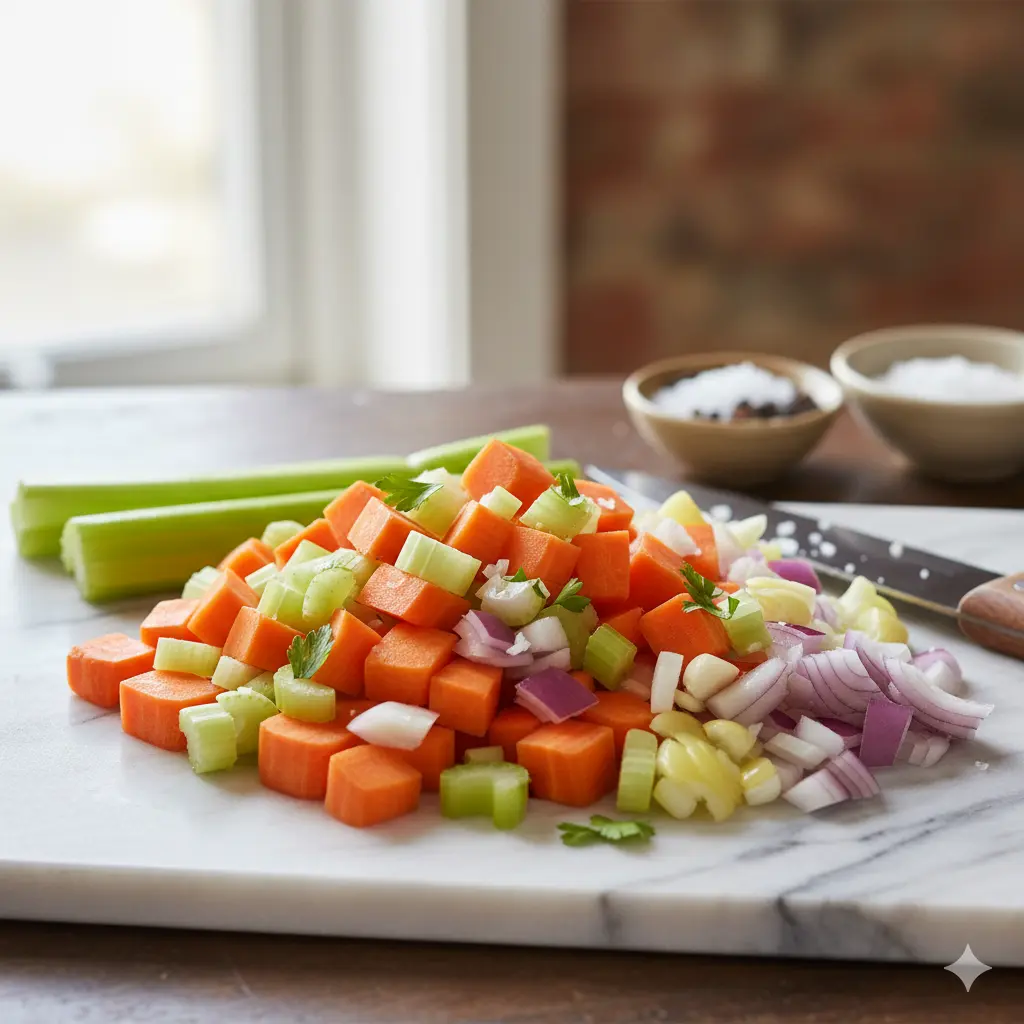
Essential Ingredients for Authentic Italian Penicillin Soup
The beauty of this recipe lies in its simplicity. You need just a handful of wholesome ingredients to create magic in a pot.
Core Ingredients
Pastina (Star-Shaped Pasta): The signature element! Look for “stelline” (little stars), “acini di pepe” (peppercorns), or “ditalini” (little thimbles). In 2025, many brands offer gluten-free versions using brown rice or chickpea flour—equally delicious. If you can’t find pastina, orzo or small elbow macaroni work in a pinch.
Pro Tip: Cook pastina separately and add to individual bowls to prevent mushiness if meal-prepping. This trick keeps your soup fresh for days.
Broth Base:
- Chicken Broth: Traditional and rich in amino acids (8 cups for standard recipe)
- Vegetable Broth: Plant-based alternative with equally comforting results
- Bone Broth: Next-level collagen boost for joint and skin health
The Aromatic Trinity Plus One:
- 4 large carrots (peeled and diced)
- 3 celery ribs (finely chopped)
- 1 large yellow onion (diced)
- 6 cloves garlic (minced—never skimp on garlic!)
Seasonings:
- 2 tablespoons extra virgin olive oil
- 1 teaspoon sea salt (adjust to taste)
- ½ teaspoon black pepper
- ½ teaspoon Italian seasoning (or fresh herbs like thyme and oregano)
- Optional: 1 bay leaf, pinch of red pepper flakes
Optional Additions:
- Fresh ginger (1-inch piece, grated—adds extra anti-inflammatory power)
- Parmesan rind (simmer in broth for umami depth)
- Fresh spinach or kale (stir in at the end for greens)
- Lemon juice (brightens flavors beautifully)
Garnishes:
- Freshly grated Parmesan cheese
- Fresh parsley or basil
- Crusty bread or sourdough protein pancakes on the side for a modern twist
Shopping Note: For a complete Italian-inspired meal plan, pair this with our creamy garlic chicken pasta with spinach for dinner variety throughout the week.
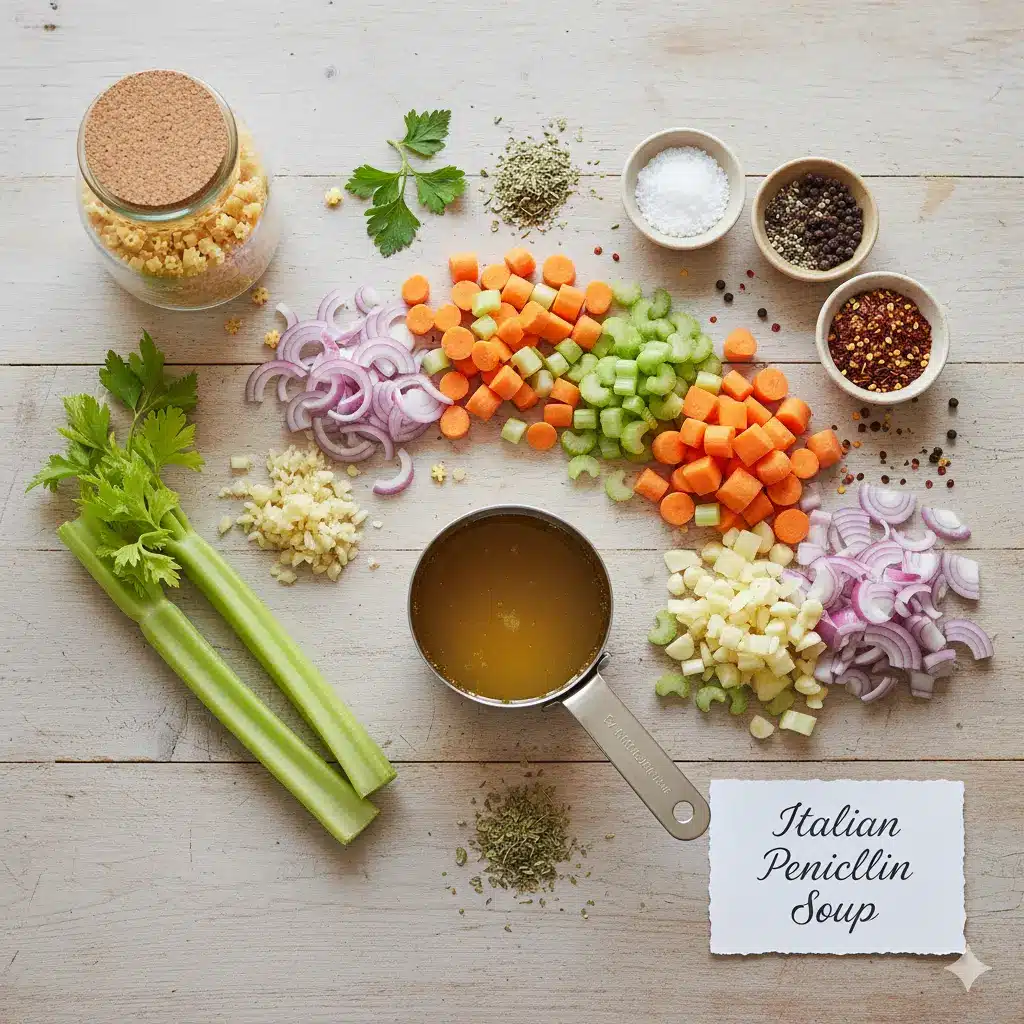
Step-by-Step: How to Make Italian Penicillin Soup (30 Minutes!)
Making Italian Penicillin Soup is remarkably easy—perfect for when you’re not feeling 100% but still want something homemade and nourishing.
Preparation Steps
Prep Time: 10 minutes
Cook Time: 20 minutes
Total Time: 30 minutes
Servings: 6 hearty bowls
The Foolproof Method
Step 1: Prepare Your Vegetables (5 minutes) Peel and dice carrots into small, uniform pieces (about ¼-inch). Finely chop celery, dice onion, and mince garlic. Having everything prepped before you start cooking ensures even cooking and prevents burning.
Step 2: Sauté the Aromatics (8 minutes) Heat 2 tablespoons of olive oil in a large Dutch oven or stockpot over medium heat. Add the diced onion with a pinch of salt and cook for 3-4 minutes until translucent and fragrant. Add minced garlic and sauté for another 1-2 minutes, stirring constantly to prevent burning. The kitchen should smell absolutely incredible at this point!
Step 3: Add Carrots and Celery (5 minutes) Toss in your chopped carrots and celery. Season with salt, pepper, and Italian seasoning. Sauté for about 5 minutes, stirring occasionally, until the vegetables begin to soften slightly and develop a light golden color on the edges.
Step 4: Pour in the Broth Add 8 cups of chicken broth or vegetable broth to the pot. If using, drop in a bay leaf or Parmesan rind for extra depth. Bring the mixture to a boil, then reduce heat to maintain a gentle simmer.
Step 5: Simmer Until Tender (10 minutes) Let the soup simmer uncovered for 10-12 minutes until all vegetables are tender and the flavors have melded beautifully. Taste and adjust seasonings as needed.
Step 6: Cook the Pastina Here’s where technique matters! You have two options:
Option A (Quick & Easy): Add 1 cup of dry pastina directly to the pot and cook for 5-7 minutes until al dente, stirring occasionally.
Option B (Meal Prep Friendly): Cook pastina separately in salted boiling water according to package directions, drain, and add to individual bowls when serving. This prevents the pasta from absorbing too much broth and getting mushy during storage.
Step 7: Final Touches Remove from heat. Squeeze in fresh lemon juice if desired (about 1 tablespoon). Taste one more time and adjust salt/pepper. If adding fresh greens like spinach, stir them in now—the residual heat will wilt them perfectly.
Step 8: Serve with Love Ladle hot soup into bowls, making sure each serving gets plenty of vegetables and pastina. Top with freshly grated Parmesan cheese and chopped fresh parsley. Serve immediately with crusty bread for dipping.
Expert Tip from a Registered Dietitian: “The key to maximizing the anti-inflammatory benefits is not overcooking the garlic. Add it after the onions have softened and cook just until fragrant—about 60-90 seconds. This preserves the beneficial allicin compounds that give garlic its healing properties.” —Blair Ward, RD
Trending Now: Many home cooks in 2025 are batch-cooking this soup on Sundays alongside meal planning tips for an entire week of easy, healthy dinners.
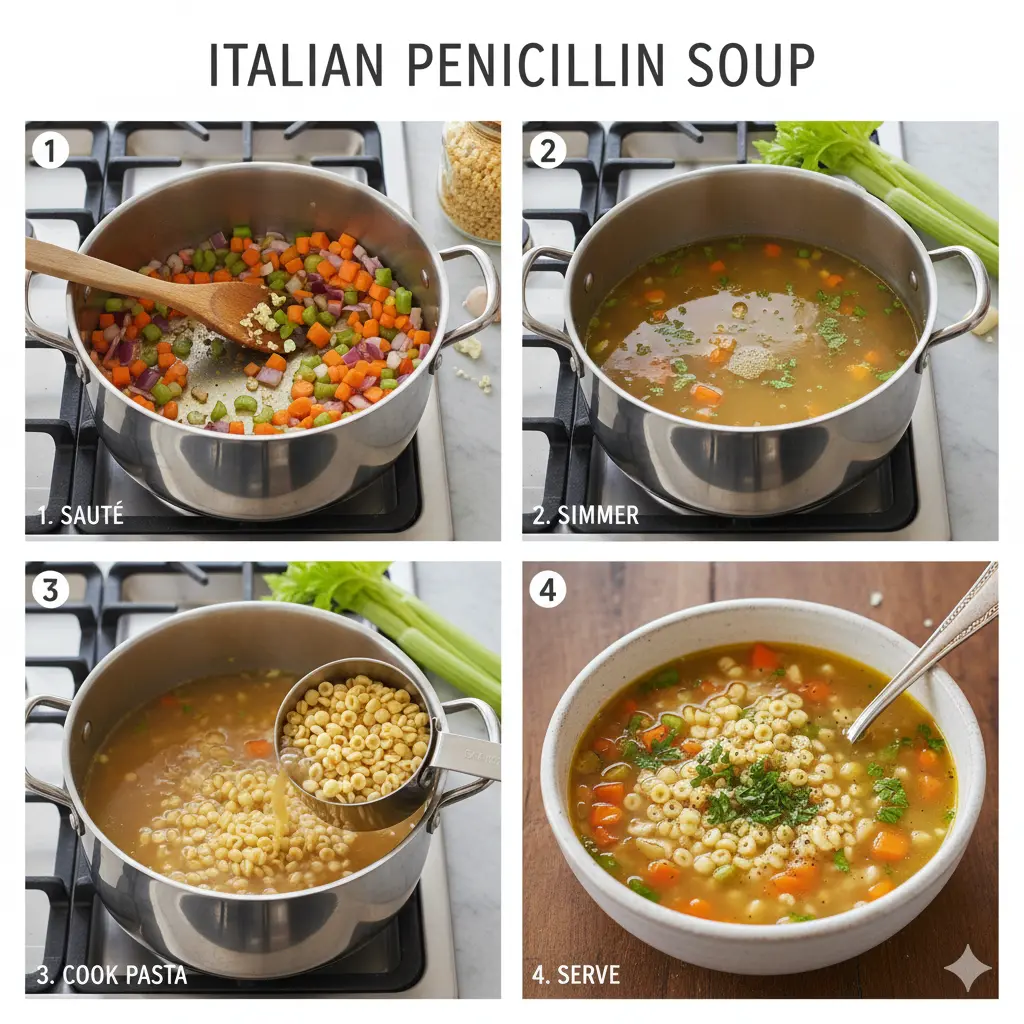
Italian Penicillin Soup Variations for Every Diet
One of the reasons this soup has gone viral is its incredible versatility. Here’s how to adapt it for different dietary needs and preferences:
Classic Chicken Version (Protein-Packed)
Add 1 pound of boneless, skinless chicken thighs or breasts to the broth in Step 4. Simmer until cooked through (about 15 minutes), remove, shred with two forks, and return to the pot. This creates a heartier meal similar to our leftover chicken noodle soup recipe easy comfort.
Nutrition Boost: Chicken adds approximately 25g of protein per serving and creates an even more satisfying meal.
Vegan Italian Penicillin Soup (Plant-Based Power)
Replace chicken broth with vegetable broth and add these plant-powered ingredients:
- 1 cup cooked white beans or chickpeas (protein + fiber)
- 1 cup diced mushrooms (umami depth)
- 2 tablespoons nutritional yeast (B vitamins + cheesy flavor)
- ½ teaspoon turmeric (anti-inflammatory superfood)
Check out our simple healthy recipes collection for more plant-based meal ideas.
Gluten-Free Version
Simply swap regular pastina for gluten-free pasta options:
- Brown rice stelline (Jovial brand is excellent)
- Chickpea pasta stars
- Quinoa-based small pasta shapes
Make sure your broth is certified gluten-free, as some brands contain wheat-derived ingredients.
Low-Sodium Heart-Healthy Version
For those watching sodium intake, this soup adapts beautifully:
- Use no-salt-added or low-sodium broth
- Season with herbs instead of salt (basil, oregano, thyme)
- Add extra lemon juice for brightness without sodium
- Include potassium-rich vegetables like spinach
Similar to our low-sodium classic chicken noodle soup recipe, you won’t sacrifice flavor!
Kid-Friendly “Hidden Veggie” Version
Here’s the viral TikTok trick that parents are obsessed with:
After Step 5 (when vegetables are tender), use an immersion blender to partially blend the soup, creating a creamy, cloudy broth where vegetables “disappear.” Kids get all the nutrition without the texture they might resist. Add the pastina after blending for the fun shapes they love.
Immune-Boosting “Sick Day” Version
When you’re really under the weather, amp up the healing power:
- Add 2-inch piece of fresh ginger (grated)
- Include 1 teaspoon turmeric powder
- Toss in 2 cups fresh spinach at the end
- Squeeze extra lemon juice before serving
- Top with extra garlic (raw or roasted)
Pair with our anti-inflammatory diet guidelines for comprehensive wellness support.
Keto/Low-Carb Version
Replace pastina with:
- Shirataki (konjac) noodles (almost zero carbs)
- Cauliflower rice (added in last 3 minutes)
- Zucchini noodles (spiralized, added at the end)
This keeps the soup under 10g net carbs per serving. You might also enjoy our keto grilled chicken caesar salad for more low-carb Italian-inspired meals.
Myth vs. Fact Box 2:
MYTH: Italian Penicillin Soup must include chicken to be authentic. FACT: Traditional Italian pastina soup is often vegetarian! The “penicillin” nickname comes from the healing vegetables and broth, not necessarily chicken. Many Italian families serve it meatless, especially during Lent.
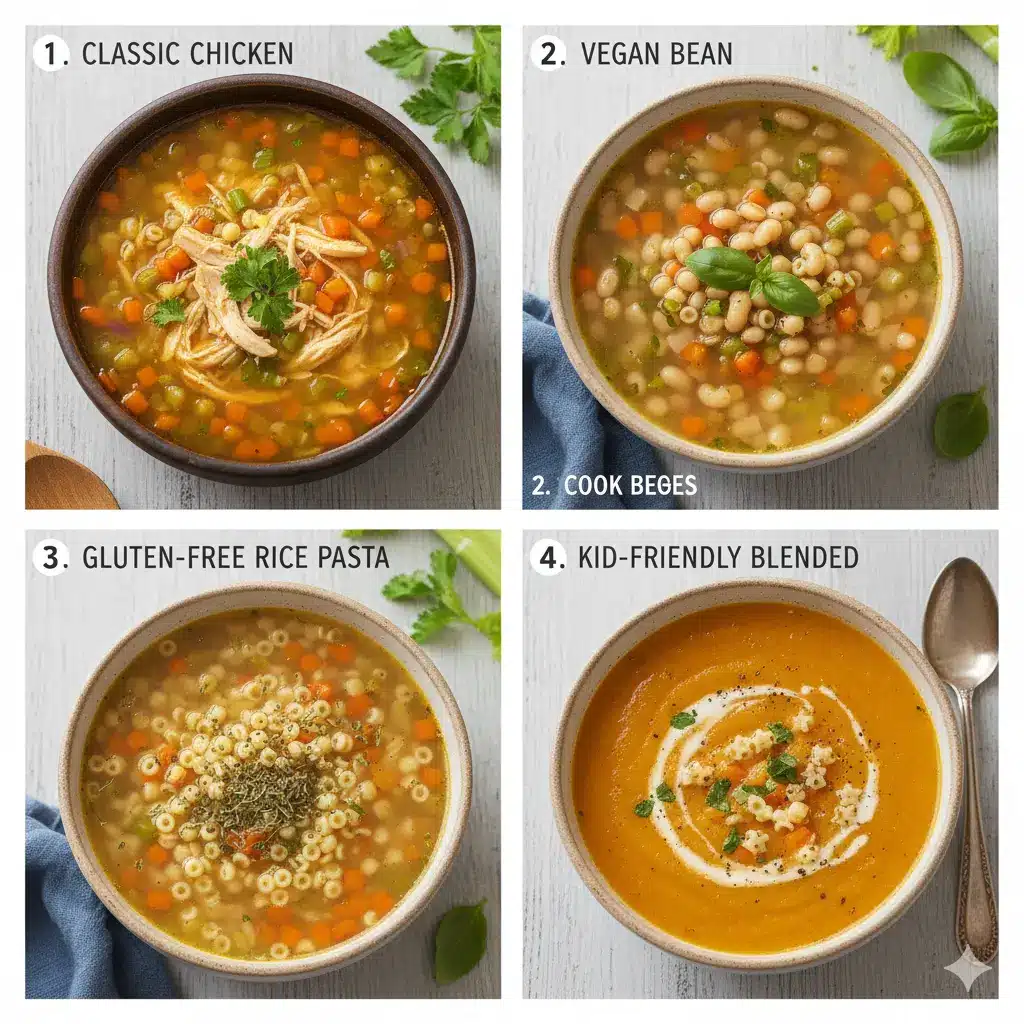
Storage, Meal Prep, and Freezing Guide
Italian Penicillin Soup is a meal-prepper’s dream. Here’s how to store it perfectly:
Refrigerator Storage (5 Days)
Best Method: Store broth and cooked pasta separately in airtight containers. When ready to eat, reheat the broth and pour over a portion of pasta. This prevents mushiness.
Quick Method: If you don’t mind softer pasta, store the complete soup together for up to 5 days. The pasta will absorb broth over time, so you may need to add extra liquid when reheating.
Freezer Storage (3 Months)
Pro Tip: Freeze the broth with vegetables but WITHOUT pasta. Pastina doesn’t freeze well and becomes mushy when thawed. When ready to eat, thaw the broth, reheat, and cook fresh pastina to add.
Portion Sizing: Freeze in 2-cup portions using freezer-safe containers or bags. Label with date and contents. This makes it easy to thaw just what you need.
Reheating Instructions
- Stovetop: Best method for maintaining texture. Heat over medium until simmering, about 5 minutes.
- Microwave: Heat in 1-minute intervals, stirring between, until hot throughout.
- From Frozen: Thaw overnight in refrigerator, or place frozen container in warm water until partially thawed, then heat.
Batch Cooking Strategy
Make a double or triple batch! This soup scales beautifully. Cook vegetables and broth in a large stockpot, then freeze in multiple containers for quick meals throughout the month.
Many readers batch-cook this alongside our 7-day smoothie weight loss diet plan for a complete week of healthy eating.
Quick Meal Prep Checklist:
□ Prep vegetables on Sunday (store in fridge up to 3 days)
□ Make broth base (refrigerate or freeze)
□ Keep dry pastina in pantry for quick additions
□ Pre-portion into containers with lids
□ Label all containers with dates
□ Freeze extras for emergency sick-day meals
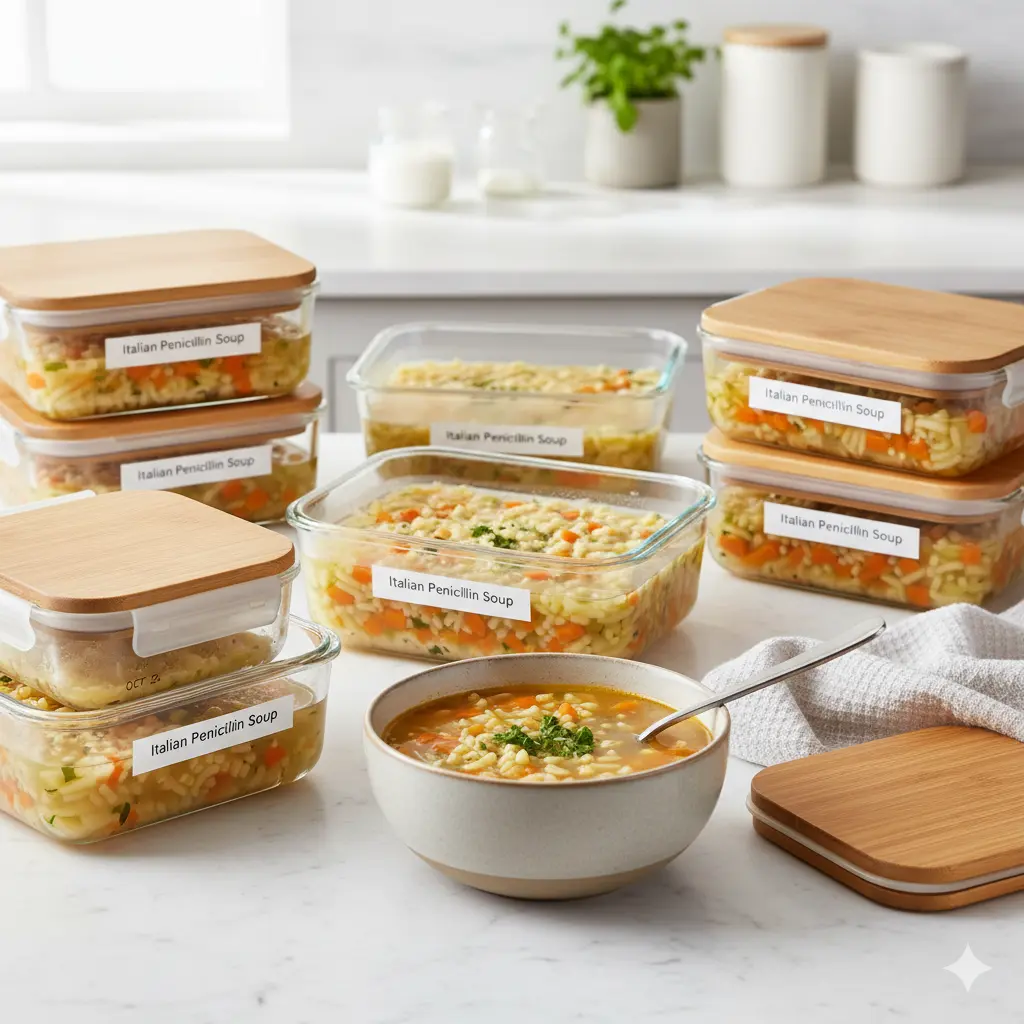
Nutritional Benefits and Calorie Breakdown
Understanding what you’re eating helps you appreciate this soup even more:
Per Serving (1.5 cups, approximately):
- Calories: 180-220 (depending on broth type)
- Protein: 8-12g (higher with chicken)
- Carbohydrates: 28-32g
- Fiber: 4-6g
- Fat: 4-6g
- Sodium: 600-900mg (varies by broth brand)
- Vitamin A: 120% DV (from carrots)
- Vitamin C: 15% DV
- Potassium: 450mg
Health Benefits Summary
Hydration Support: The high water content helps maintain hydration during illness—crucial for recovery and immune function.
Low-Calorie Nutrition: At under 220 calories per generous serving, it’s nutrient-dense without being calorie-heavy, making it perfect for weight loss strategies when paired with balanced meals.
Gut-Friendly: Easily digestible and gentle on sensitive stomachs. The vegetables provide prebiotic fiber that feeds beneficial gut bacteria.
Anti-Inflammatory: Garlic, onions, and olive oil all contain compounds that reduce systemic inflammation—key for chronic health conditions.
Immune System Support: Vitamins A and C, zinc (if using chicken), and antioxidants all contribute to stronger immune responses.
For readers focused on holistic wellness, combine this with our anti-inflammatory foods list for maximum health benefits.
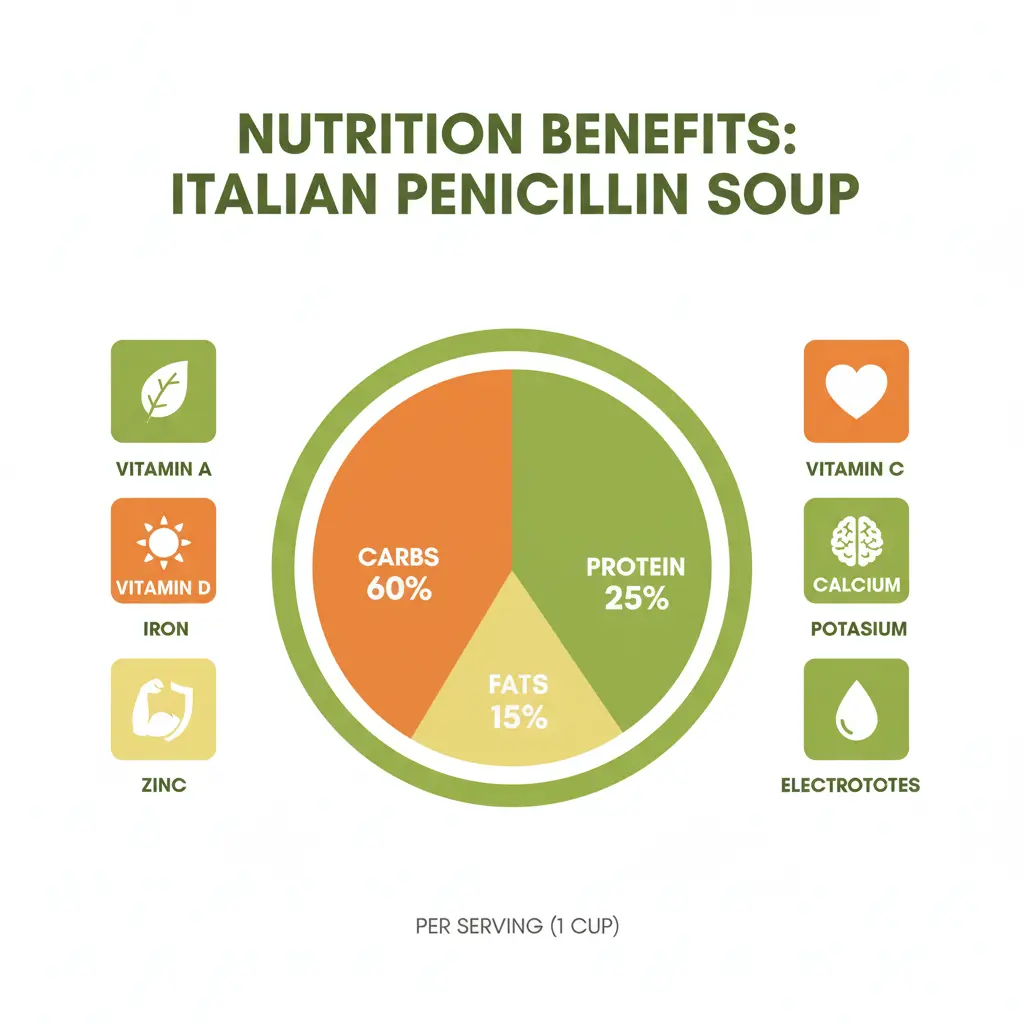
Serving Suggestions and Perfect Pairings
While Italian Penicillin Soup is wonderful on its own, these pairings elevate it to a complete, satisfying meal:
Bread and Crackers
- Crusty Italian Bread: The classic choice—perfect for dipping and soaking up every drop of broth
- Garlic Bread: Because garlic + garlic = immune system heaven
- Sourdough: Tangy flavor complements the soup’s savory notes
- Crackers: Saltines or whole-grain crackers for texture contrast
Salads
Light, fresh salads balance the warm, comforting soup:
- Simple arugula salad with lemon vinaigrette
- Caesar salad (try our grilled chicken caesar salad recipe)
- Checkerboard salad recipe for a stunning presentation
Protein Add-Ons
If you want to make this a heartier meal without cooking chicken in the soup:
- Rotisserie chicken (shredded on top)
- Pan-seared salmon (on the side)
- Italian sausage links (grilled)
- Hard-boiled eggs (halved in the bowl)
Beverage Pairings
- Hot Herbal Tea: Ginger or chamomile complements the healing vibe
- Sparkling Water with Lemon: Cleanses the palate
- White Wine: A light Pinot Grigio for adult dinners
- Lemon Balm Recipe Refreshing Herbal Drink: Perfect wellness beverage pairing
Complete Meal Ideas
Cozy Sick Day Lunch: Italian Penicillin Soup + garlic bread + hot tea + smoothie for extra vitamins
Family Dinner: Italian Penicillin Soup + big green salad + creamy vegetable soup recipe as a second option + crusty bread basket
Meal Prep Lunch: Italian Penicillin Soup (in thermos) + sourdough protein pancakes + fruit
Common Questions About Italian Penicillin Soup (FAQ)
Can I make Italian Penicillin Soup in a slow cooker?
Absolutely! Add all vegetables and broth to your slow cooker. Cook on LOW for 6-7 hours or HIGH for 3-4 hours. Add pastina in the last 15 minutes of cooking with the slow cooker on HIGH, or cook pasta separately and add when serving.
What’s the difference between pastina and orzo?
Pastina refers to very tiny pasta shapes (stars, letters, tiny tubes) traditionally used in Italian soups, especially for children. Orzo is rice-shaped pasta that’s slightly larger. Both work in this soup, but pastina is more traditional and cooks faster.
Can I use store-bought rotisserie chicken?
Yes! This is a fantastic time-saver. Shred about 2 cups of meat from a rotisserie chicken and add it to the soup in the last 5 minutes of cooking just to heat through. This method gives you all the chicken flavor with minimal effort.
How do I make the broth more flavorful?
Several tricks work beautifully:
- Add a Parmesan rind while simmering (remove before serving)
- Use homemade or high-quality store-bought broth
- Sauté vegetables until slightly caramelized for deeper flavor
- Add a splash of white wine after sautéing aromatics (cook off alcohol)
- Include fresh herbs like thyme, rosemary, or bay leaf
Is Italian Penicillin Soup actually good for colds?
While no food can “cure” a cold, Italian Penicillin Soup does provide genuine benefits: hydration from the broth, anti-inflammatory compounds from garlic and onions, easy-to-digest carbohydrates for energy, and vitamins that support immune function. The warm steam also helps clear nasal passages. Many people report feeling noticeably better after eating it.
Can I add other vegetables?
Definitely! Popular additions include:
- Zucchini (diced, added in last 5 minutes)
- Spinach or kale (wilted at the end)
- Peas (frozen, added in last 3 minutes)
- Tomatoes (diced, for a different flavor profile)
- Mushrooms (sautéed with the aromatics)
What if I can’t find pastina?
No problem! Use any small pasta shape: orzo, ditalini, small shells, alphabet pasta, or even broken spaghetti. Israeli couscous also works beautifully. The key is keeping the pasta small so it cooks quickly and is easy to eat with a spoon.
How can I make this soup spicier?
Add red pepper flakes while sautéing the aromatics, include a diced jalapeño with the vegetables, stir in a spoonful of calabrian chili paste, or drizzle with hot honey recipe before serving for a sweet-heat combo.
Is this soup suitable for babies and toddlers?
Yes! Italian Penicillin Soup is traditionally served to young children in Italy. For babies (8+ months), puree or mash it to appropriate consistency and reduce salt significantly. For toddlers, the small pasta shapes make it easy to eat. Always check with your pediatrician before introducing new foods.
Expert Tips and Tricks for Perfect Italian Penicillin Soup Every Time
After making hundreds of batches and learning from Italian nonnas, here are the insider secrets:
The Golden Rules
1. Don’t Rush the Aromatics Take your time sautéing the onions and garlic. This builds the flavor foundation. Onions should be translucent and fragrant, garlic should be golden but not brown.
2. Size Matters for Even Cooking Cut all vegetables roughly the same size (about ¼-inch dice). This ensures everything cooks evenly and looks professional in the bowl.
3. Taste and Adjust Throughout Season in layers—add salt when sautéing vegetables, adjust after adding broth, and taste one final time before serving. Broth brands vary in saltiness, so always taste first.
4. The Pasta Timing Trick If eating immediately: Add pasta directly to pot. If meal prepping: Cook pasta separately. If freezing: Don’t add pasta at all until serving day.
5. Fresh Herbs Make a Difference While dried Italian seasoning works, fresh herbs (especially parsley and basil) added right before serving brighten the entire dish. Rough chop and sprinkle generously.
Advanced Techniques
Browning the Vegetables: For even deeper flavor, let the carrots and celery develop some golden-brown edges before adding broth. This caramelization adds natural sweetness and complexity.
Layered Seasoning: Add half your salt and herbs at the beginning, the other half at the end. This creates more dimensional flavor than seasoning all at once.
The Parmesan Rind Secret: Italian grandmothers always save Parmesan rinds for soup. The rind infuses the broth with rich, umami flavor as it simmers. Fish it out before serving.
Acid Brightening: A squeeze of fresh lemon juice (about 1 tablespoon) right before serving makes all the flavors pop. This is the professional chef trick that takes good soup to great soup.
Temperature Control: Never let the soup boil rapidly once you’ve added the broth. A gentle simmer keeps vegetables tender, not mushy, and prevents the broth from reducing too quickly.
Common Mistakes to Avoid
❌ Overcooking the Pasta: Mushy pasta ruins the texture. Cook just to al dente—it will continue softening in the hot broth.
❌ Burning the Garlic: Garlic turns bitter when burned. Add it after the onions have softened and cook only 60-90 seconds.
❌ Using Poor-Quality Broth: Since broth is the main ingredient, quality matters. Look for brands with minimal sodium and no added MSG.
❌ Skipping the Oil: The olive oil isn’t optional—it helps vegetables caramelize and carries fat-soluble vitamins and flavors throughout the soup.
❌ Adding Too Much Pasta: Use about 1 cup of dry pasta for 8 cups of broth. Too much pasta makes it gloppy instead of soupy.
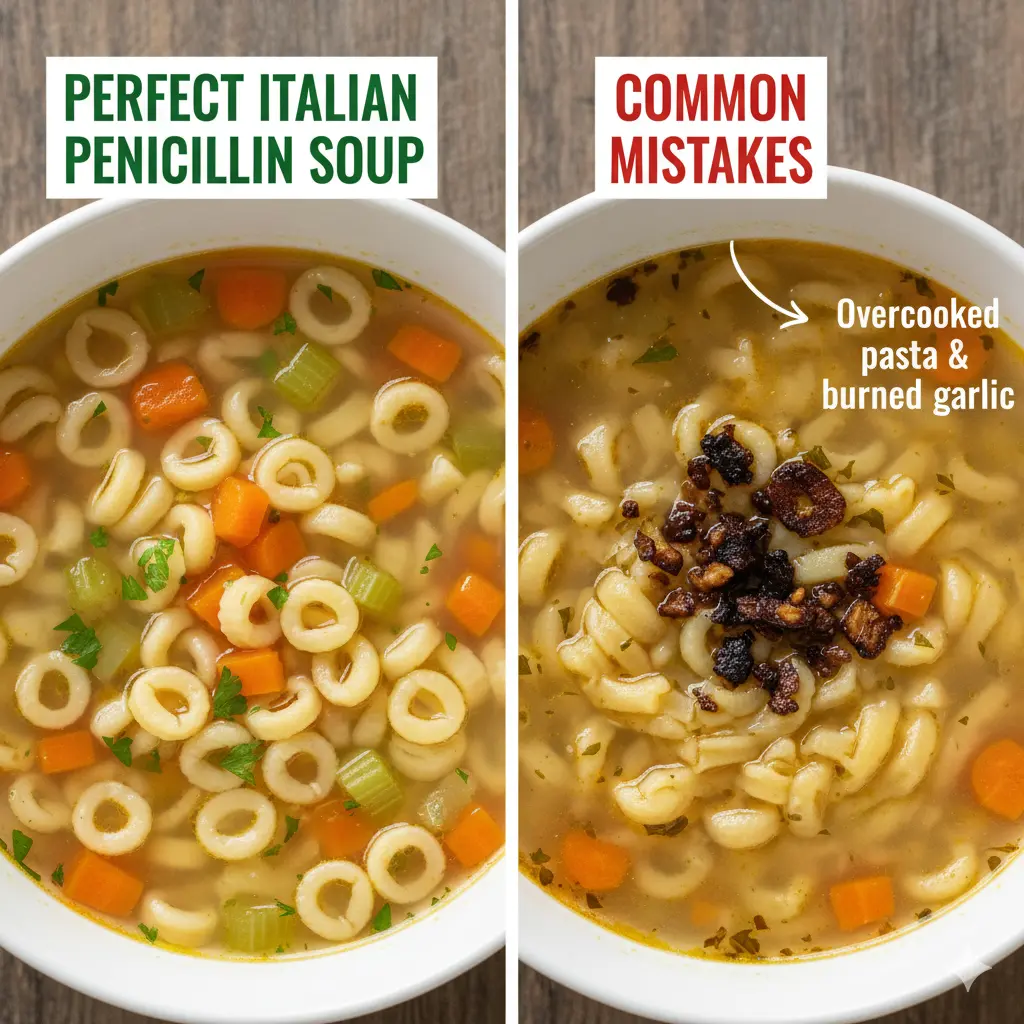
The Cultural History: Why Italian Grandmothers Swear By This Soup
Italian Penicillin Soup isn’t just a recipe—it’s a cultural tradition passed down through generations. Understanding its roots makes every bowl more meaningful.
Origins in Italian Tradition
In Italian culture, food is medicine. The concept of “cibi curativi” (healing foods) has been central to Italian cooking for centuries. Pastina soup emerged as the ultimate comfort food for several reasons:
For Children: The tiny pasta shapes were easy for small hands to manage and gentle on developing digestive systems.
For the Sick: Light, hydrating, and easy to digest, it became the go-to meal for anyone feeling under the weather.
For the Elderly: Soft, nourishing, and requiring minimal chewing, it provided sustenance without strain.
For New Mothers: Considered fortifying and gentle for postpartum recovery.
The “Penicillin” Nickname
While some attribute the nickname to Italian-American communities in the early 20th century (around the time penicillin was discovered), others trace it to the timeless wisdom of nonnas who understood intuitively what science later confirmed: that the vegetables in this soup contain antimicrobial and anti-inflammatory compounds.
The name stuck because, quite simply, it worked. Generation after generation experienced relief from colds, flu, and general malaise after eating this soup.
Regional Variations Across Italy
Northern Italy (Lombardy, Piedmont): Often includes butter instead of olive oil, and sometimes a spoonful of cream for richness.
Central Italy (Tuscany, Umbria): Emphasizes simple ingredients with high-quality olive oil and the addition of cannellini beans.
Southern Italy (Campania, Sicily): May include a touch of tomato and more garlic, with a drizzle of extra virgin olive oil at serving.
Italian-American: The version that went viral on TikTok, typically featuring the vegetable base with options for chicken or keeping it vegetarian.
Modern Revival and Social Media
In 2024-2025, Italian Penicillin Soup experienced a massive revival thanks to:
- TikTok videos from Italian-American creators sharing “Nonna’s recipes”
- Wellness influencers highlighting the anti-inflammatory ingredients
- The general trend toward comforting, nostalgic “grandma food”
- Growing interest in food as medicine and gut health
The hashtag #ItalianPenicillinSoup has over 80 million views on TikTok, with creators sharing their family versions and personal stories of how “Nonna’s soup” helped them through tough times.
Similar to how Greek yogurt and peanut butter nutrition became a viral health trend, this traditional recipe found new life through social media wellness communities.
Quick Recap: Your Italian Penicillin Soup Success Checklist
Before you head to the kitchen, here’s your quick reference guide:
✅ Ingredients Ready: Pastina, broth (8 cups), carrots (4), celery (3 ribs), onion (1 large), garlic (6 cloves), olive oil, seasonings
✅ Equipment: Large pot or Dutch oven, cutting board, sharp knife, ladle, storage containers
✅ Prep Work: Dice vegetables uniformly, mince garlic, measure seasonings
✅ Cooking Order: Sauté onions → Add garlic → Add carrots & celery → Pour broth → Simmer → Add pasta → Season → Serve
✅ Storage Plan: Separate pasta from broth for meal prep, or freeze broth without pasta
✅ Customization: Choose your variation (classic, vegan, gluten-free, etc.)
✅ Serving: Garnish with Parmesan and fresh herbs, serve with crusty bread
✅ Timing: 30 minutes total from start to bowl
Conclusion: Why Italian Penicillin Soup Deserves a Spot in Your Recipe Rotation
Italian Penicillin Soup is more than just a trendy recipe—it’s a versatile, nourishing meal that delivers comfort, health benefits, and incredible flavor with minimal effort. Whether you’re meal prepping for a busy week, looking for immune-boosting foods during cold and flu season, feeding picky eaters, or simply craving a bowl of Italian comfort, this soup checks every box. For an authentic recipe, visit the official detailed guide at Jessica in the Kitchen which features a traditional and vegan-friendly version with simple ingredients and expert tips.
The beauty of this recipe lies in its simplicity and adaptability. With just a handful of wholesome ingredients and 30 minutes, you can create a pot of liquid gold that rivals anything from a fancy Italian restaurant. Plus, it’s budget-friendly, freezer-friendly, and welcomes endless customizations to suit your dietary needs and taste preferences.
As we move through 2025, the trend toward healing, nostalgic, and culturally-rooted recipes continues to grow. Italian Penicillin Soup represents the perfect intersection of tradition and modern wellness—a recipe that our grandmothers knew was magic, and that science now confirms truly works.
Your Turn! Have you tried making Italian Penicillin Soup? What’s your favorite variation? Do you have a family recipe passed down from your own Nonna? Share your experience in the comments below! And if you love this recipe, don’t forget to save it to your recipe collection and share it with friends who need a bowl of comfort.
For more wholesome, healing recipes, explore our complete collection of easy healthy recipes and join our community of home cooks who believe that the best medicine often comes from the kitchen.
Pin this recipe for later, and let’s keep the tradition of Italian Penicillin Soup alive for generations to come!





